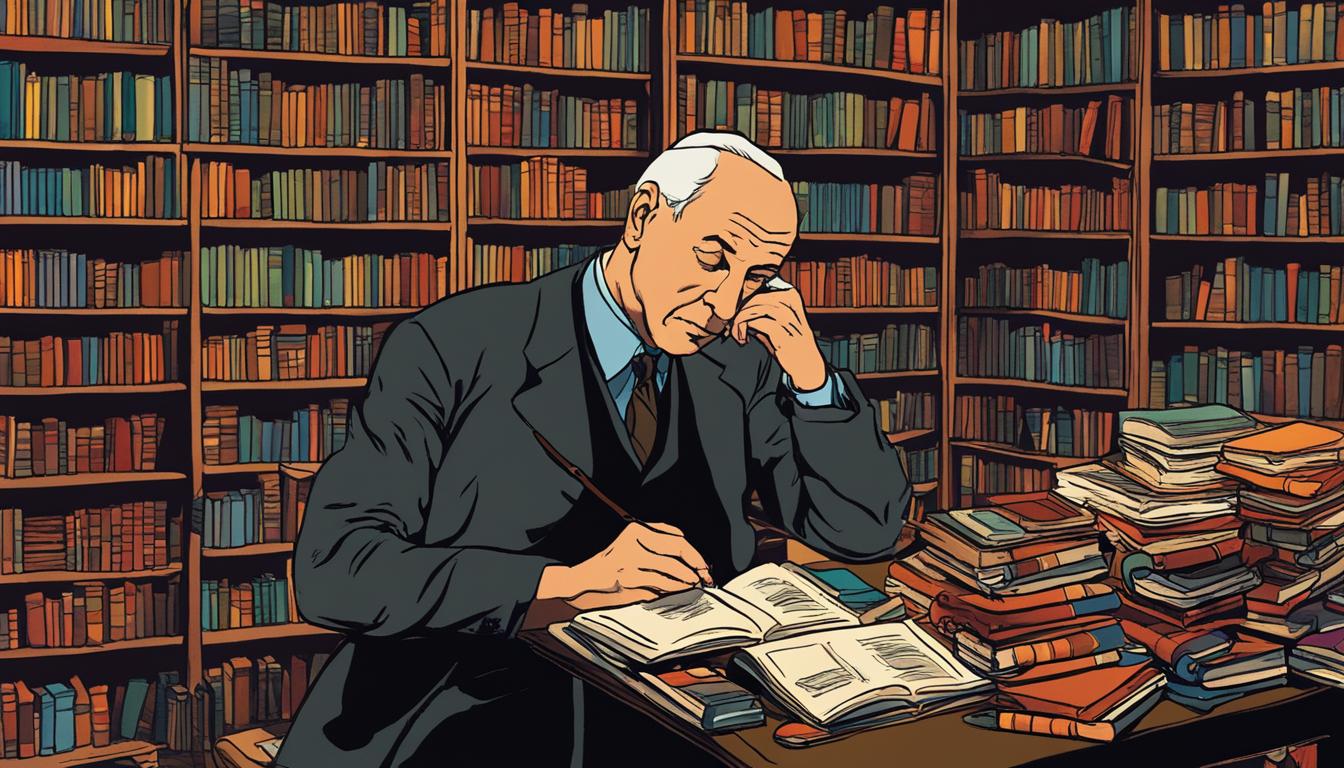If you’re looking for an engaging and thought-provoking novel, look no further than “Ravelstein” by Saul Bellow. This masterpiece, first published in 2000, explores many complex themes and ideas that are sure to captivate readers. In our comprehensive book summary, we will delve into the plot, analyze the characters and their motivations, explore the novel’s themes and symbolism, and examine Bellow’s writing style and language.
Whether you’re a longtime fan of Bellow’s works or just discovering his writing for the first time, our book summary will provide you with everything you need to know about “Ravelstein.” So, sit back, relax, and join us on this literary journey through the world of Saul Bellow’s fascinating novel.
Get ready to immerse yourself in the world of Ravelstein, as we guide you through the story’s intricacies, providing you with valuable insights into one of the greatest works of contemporary literature. Let’s start by taking a closer look at our comprehensive book summary of “Ravelstein.”
Introduction to “Ravelstein”
“Ravelstein” is a novel written by the renowned author, Saul Bellow. Set in the late 1990s, the book explores various themes that are highly relevant to contemporary society. In this section, we will delve into the background of the novel and discuss its primary themes, providing readers with a glimpse into the world they will be exploring throughout our summary.
The novel mainly centers around the character of Ravelstein, who is based on Allan Bloom, a philosopher, and academic. Bellow portrays Ravelstein as a larger-than-life intellectual figure who is both charismatic and controversial, making the book an exciting read. The novel deals with various themes, including politics, sexuality, mortality, and relationships, among others.
Themes in “Ravelstein”
The novel is rich in themes that give it depth and make it a masterpiece worth reading. The primary themes in the novel include:
- Mortality
- Sexuality
- Relationships
- Politics
- Culture
- Philosophy
The themes are explored in-depth in the book, and Bellow uses them to make insightful commentaries on contemporary society, the human condition, and the nature of life itself. The book is a masterpiece on all levels, and its themes will resonate with readers long after finishing it.
Plot Summary
In “Ravelstein” by Saul Bellow, readers follow the life of Abe Ravelstein, a prominent professor, and his friend Chick. One day, Ravelstein shocks Chick by revealing that he will die soon. These words spur Chick on to record the life story of his friend, revealing to readers the many intricate details of Ravelstein’s life as a political philosopher, his wild affairs with lovers, and the friendships that defined his existence.
The novel possesses a unique structure in which the plot emerges through Chick’s recollections and stories. Chick reveals the depths of Ravelstein’s character and the various struggles he faced throughout his life. For example, readers learn about Ravelstein’s difficult childhood experiences, his misadventures in Paris, and his deep dive into the world of academia. As the plot progresses, Ravelstein’s deteriorating health raises the stakes, leading to an inevitable confrontation with death that brings together the threads of Ravelstein’s life.
The plot twists and turns, covering a plethora of life events, both personal and public. From Ravelstein’s political philosophies to his secret love affairs and battles with health, the novel brims with liveliness and vividness. Bellow showcases his prowess as a storyteller by bringing these twists and turns together in a way that submerses the reader within the story’s world.
Character Analysis
In “Ravelstein,” Saul Bellow presents readers with a diverse cast of characters, each playing a crucial role in the narrative. The central figure is Abe Ravelstein, an enigmatic and charismatic professor of political philosophy at the University of Chicago who has recently undergone a spiritual awakening.
Throughout the novel, we witness Ravelstein’s relationships with his closest confidants, including his best friend, narrator Chick, and his lover, Nikki. While Ravelstein serves as the linchpin of the story, his relationships with these characters, as well as his strained connection with his ex-wife and estranged son, are all critical components in understanding his character.
Moreover, Bellow explores the motivations, desires, and inner workings of each character, offering readers a complex and nuanced portrait of human nature. The analysis of these characters reveals the underlying themes of the novel, including the human search for meaning and fulfillment.
“Human nature cannot be predicted. That is what science teaches us. There are too many variables in the human equation; you can’t just solve for x like you do in physics.”
Themes and Symbolism
In “Ravelstein,” Saul Bellow weaves a complex web of themes and symbols that add depth and richness to the novel. One of the central themes of the book is the concept of self-discovery and personal growth. As the protagonist, Abe Ravelstein, confronts his mortality, he is forced to confront his own flaws and weaknesses, and ultimately undergoes a transformation that leads to a greater sense of understanding and acceptance.
Another prominent theme in the book is the idea of intellectualism and the role of the intellectual in society. Bellow explores this theme through Ravelstein, who is a renowned professor and philosopher. Through Ravelstein’s character, the author examines the relationship between intellectualism and power, and raises important questions about the responsibility that comes with knowledge and influence.
Symbolism also plays a significant role in “Ravelstein,” with various objects and images used to represent deeper ideas and concepts. For example, the broken watch that Ravelstein carries with him throughout the book can be interpreted as a symbol of mortality and the finite nature of time. Similarly, the recurring image of the sea serves as a metaphor for the unpredictability and vastness of the human experience.
“Ravelstein is a novel that is teeming with symbolism and deep-rooted themes that will leave readers pondering its hidden depths long after they have finished the novel.” – The New York Times Book Review

Writing Style and Language
Saul Bellow’s writing style and language are integral to the success of “Ravelstein,” shaping the novel’s tone, pacing, and overall impact. Bellow’s prose is marked by its richness and complexity, employing intricate sentence structures, intricate vocabulary, and a distinctively intellectual voice.
At times, Bellow’s language can be dense and challenging, requiring the reader to invest time and effort in understanding the author’s meaning. However, this investment is often rewarded with moments of profound insight and clarity.
Bellow’s writing style is also notable for its memorable characters, vivid descriptions, and masterful use of literary devices such as allegory, symbolism, and metaphor. His ability to interweave complex themes and ideas within the narrative adds depth and nuance to the reading experience.
“The peculiar grace of a Shakespearian play, it seems to me, is to present a complex, vividly illumined instance of human experience as a kind of symbol.” – Saul Bellow
Literary Devices
Bellow’s use of literary devices is a crucial part of his writing style, contributing to the layering of meaning and the creation of an emotionally resonant story.
| Device | Description | Example |
|---|---|---|
| Symbolism | When an object represents an idea or concept in a story | The metaphorical use of the city of Chicago as a microcosm of the American Dream in “The Adventures of Augie March” |
| Allegory | When a story has a deeper, symbolic meaning beyond the surface level of the plot | The journey of Moses Herzog in “Herzog” as a meditation on the nature of existence and the search for meaning |
| Metaphor | The comparison of two things, often dissimilar, to highlight a deeper meaning | The use of the sea as a metaphor for the vastness of human experience in “Humboldt’s Gift” |
Overall, Bellow’s writing style and language are vital components of “Ravelstein,” contributing to the novel’s enduring impact and critical acclaim.
Critical Reception and Legacy
The critical reception of “Ravelstein” has been overwhelmingly positive, with many applauding Saul Bellow’s masterful storytelling and skillful exploration of weighty themes. The novel has garnered numerous awards, including the National Book Award for Fiction and the Ambassador Book Award for Fiction.
Author Matthew Arnold praises the work for its “profound intelligence and remarkable insight into the human condition.” Similarly, the New York Times lauded Bellow’s “elegant prose and astute observations,” noting that “Ravelstein” marks a high point in the author’s illustrious career.
“[Ravelstein] is not just another work of fiction, but a true masterpiece of literature which will stand the test of time. Bellow’s genius for storytelling and character development is on full display here, and readers will be left breathless by the novel’s enduring beauty and profound truths.”
The legacy of “Ravelstein” continues to be felt throughout the literary world, with many citing the novel as a cornerstone of modern American literature. Its themes of friendship, mortality, and the pursuit of intellectual and spiritual enlightenment have resonated deeply with readers across generations, solidifying Saul Bellow’s place as one of the most important writers of the 20th century.
Comparison to Other Works by Saul Bellow
While “Ravelstein” certainly stands out as a unique work in Saul Bellow’s literary repertoire, it also bears some notable similarities to his other works. One of the most striking similarities is the way in which Bellow explores the complex relationships between his characters, which is a common theme throughout many of his novels.
For example, in “Seize the Day,” Bellow examines the tumultuous relationship between a father and son, while “The Adventures of Augie March” explores the protagonist’s romantic and familial relationships. Similarly, “Ravelstein” also delves into a complicated and intimate friendship between the eponymous character and the narrator, Chick.
However, one of the most significant differences between “Ravelstein” and Bellow’s other works is the degree to which it is deeply introspective. While some of his other novels, such as “Henderson the Rain King,” have introspective elements, none of them quite match the intensity and depth of “Ravelstein.”
Overall, “Ravelstein” demonstrates both an evolution in Saul Bellow’s style and a continuation of some of his most fundamental themes and motifs.
Conclusion
In conclusion, “Ravelstein” by Saul Bellow is a thought-provoking novel that explores themes of friendship, mortality, and intellectualism. Through its compelling plot and richly developed characters, Bellow presents a commentary on the nature of human relationships and the complexities of the human condition.
Overall, “Ravelstein” offers readers an engaging and memorable reading experience that is sure to linger in their minds long after they have turned the final page. Whether you are a long-time fan of Saul Bellow’s work or a newcomer to his writing, “Ravelstein” is a novel that is well worth your time and attention.
If you are looking for a captivating literary work that is both intellectually stimulating and emotionally resonant, we highly recommend “Ravelstein” as a must-read. Its themes, characters, and writing style offer a unique perspective on the world and the human experience, making it a novel that is sure to leave a lasting impression on all who read it.



